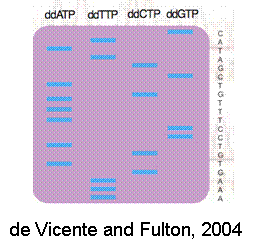Key background concept: DNA sequencing

The separation of fragments in a sequencing gel is possible because each fragment consists of a different number of bases (and therefore its size is different). The identity of the last base in each fragment is defined by which label is attached to that fragment.
The most commonly used DNA sequencing method was developed by Fred Sanger in 1977 (winning him a Nobel prize). The key is the inclusion of modified ("dideoxy") bases, which prevent the elongation of the DNA molecule. This creates a set of nested fragments, each differing in length from one another by one base. These fragments are then separated from one another by gel (or capillary) electrophoresis.






